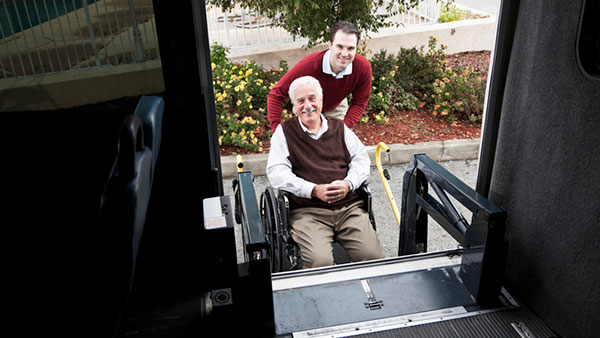
Make sure all passengers get safely to their destinations by following guidelines for wheelchair transport.
Whether you are a caregiver for the differently abled in a health facility, a home health care environment or for a family member or friend, take all appropriate safety precautions when transporting a person who uses a wheelchair.
VEHICLES
Be certain the vehicle is properly equipped to accommodate a wheelchair:
- Maintain the vehicle and have it inspected regularly
- Make sure the lift is functioning correctly
- Platform safety gate on the lift automatically deploys and retracts when the lift is operating
- Warning alert sounds when the lift is engaged
- Manual back up system for the lift functions, if needed
EQUIPMENT
Regularly inspect associated equipment:
- See that wheelchair tie-downs are adequate and in good condition
- Check wheelchair brakes
- Inspect the safety belt for correct function
- Double-check power controls for powered chairs and make sure they cannot be changed inadvertently while in the vehicle
TRAINING
Whether you’re a paid caregiver or a family member, seek out appropriate training to cover:
- Safe loading and unloading procedures
- Proper securement of the chair
- Monitoring of riders when in the vehicle
LOADING
Look for critical concerns during the loading process:
- Ensure ample loading space (rear or side)
- Avoid uneven terrain and high traffic areas
- Engage brake prior to lowering the lift
- Lower the lift to the ground
- Ensure the wheelchair safety belt is tightly fastened
- Place the wheelchair onto the lift platform following manufacturer’s instructions
- Deploy the brakes on the wheelchair and turn off (if electronic)
- ALWAYS use the platform safety strap
- Activate the lift mechanism
- Ensure the safety gate on the platform engages to prevent a roll-off
- Assist the person into the correct position in the vehicle when the lift is fully elevated to even with the vehicle floor
- Lock the two safety strap mechanisms into the floor mechanisms even with the front wheels, according to manufacturer’s recommendations
- Lock the two rear straps into the safety mechanism in the vehicle between the two rear wheelchair wheels, according to manufacturer’s recommendations
- Attach safety straps only to the frame of the wheelchair per the manufacturer’s recommendation; most wheelchairs will have transportation hooks built into the frame of the wheelchair
- Use the shoulder strap! A wheelchair seatbelt does not protect anyone in a vehicle accident
UNLOADING
Remember these steps when unloading:
- Ensure ample unloading space away from any traffic
- Deploy the lift
- Detach the shoulder strap and tie-downs from wheelchair
- Assist the person onto the lift platform
- Make sure the wheelchair is facing out for a side-loading vehicle; make sure it is facing toward the front for a rear-loading vehicle
- Ensure the wheelchair is off and the brakes are on
- Make certain that the platform safety gate is engaged
- Secure the lift safety strap
- Lower the lift all the way to the ground, from outside the van
- Carefully maneuver the wheelchair off the lift platform
- Ensure the person is safe prior to returning to the vehicle
In a busy world, it’s easy to overlook a detail when securing a wheelchair. With patience and training, you can reduce the possibility of injury and keep everyone safer.
This loss control information is advisory only. The author assumes no responsibility for management or control of loss control activities. Not all exposures are identified in this article. Contact your local, independent insurance agent for coverage advice and policy service.
